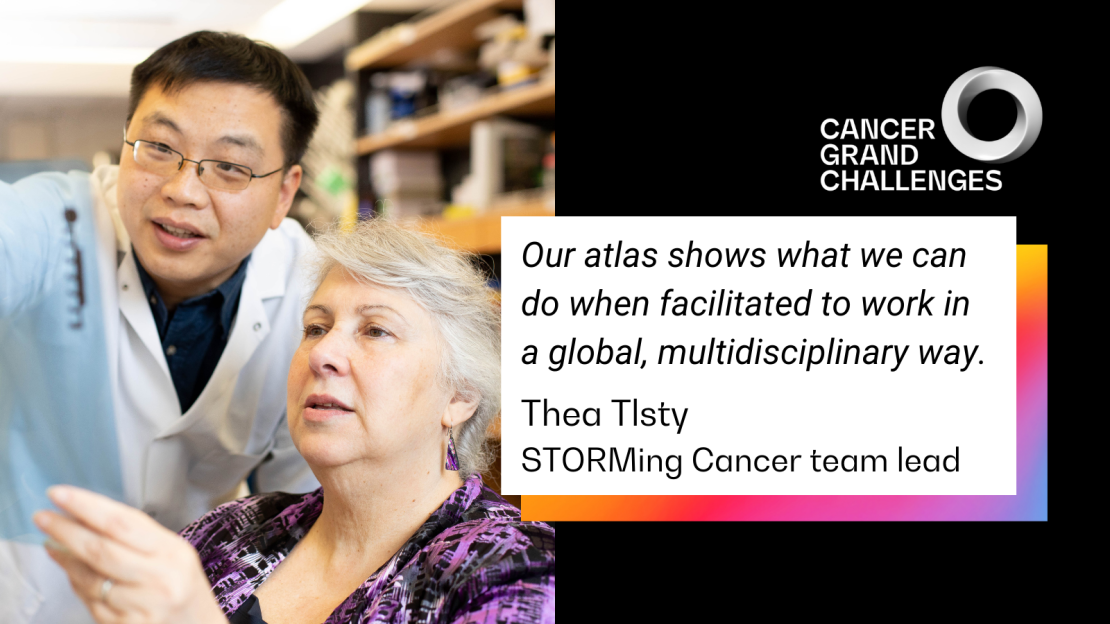From the team taking on our Cancer Causes challenge, a new integrated atlas of the stromal and epithelial interactions that drive cancers associated with chronic inflammation provides a new way to understand cancer types with the poorest survival.
Inflammation – the immune system’s normal response to injury and infection – was first linked to cancer more than 150 years ago. But despite its connection to an astounding 20% to 25% of cancer deaths worldwide, very little is known about how chronic inflammation drives cancer development. The STORMing Cancer team chose to unravel this longstanding riddle when taking on our Cancer Causes challenge.
Their approach focuses not only on the tumour cells themselves but also on their interactions with its inflamed microenvironment. This milieu comprises a web of connective tissue – the stroma, including blood vessels and the extracellular matrix – that profoundly influences epithelial cells and can coax healthy cells towards malignancy (or malignant cells towards normalcy). “Historically, the stroma’s role in cancer development has been overlooked; our hypothesis is that it’s actually the dominant driving force in the progression of chronic-inflammation-associated cancers,” explains team lead Thea Tlsty, of University California, San Francisco (USCF). "Having our programme funded was wonderful, in part because it has finally given recognition to the importance of the stroma.”
The lack of robust models that accurately mimic this overlooked aspect of human biology has been a major obstacle to understanding the relationship between cells and their inflamed surroundings. The team is now addressing this issue by constructing an integrated atlas of human tissue that maps the progression of chronic-inflammation-associated cancer, from normal tissue through all stages of inflammation, to tumour development, assessing the multiple parts of the tissue.
“Our atlas is a remarkable technical achievement that shows the breadth and depth of what you can do when facilitated to work in this global, multidisciplinary way,” says Thea.
Looking up answers in the atlas of cancer progression
The atlas will map the progression of oesophageal adenocarcinoma – which Thea describes as the ‘poster child’ for chronic inflammation in cancer. This progression often starts with acid reflux, which triggers an adaptive response to inflammation, known as metaplasia, which progresses to cancer in a small percentage of people. In a protective response, oesophageal cells are replaced with gastrointestinal cells, but this shift can increase the risk of dysplasia, or abnormal growth. Between 3% and 13% of people with metaplasia later develop oesophageal adenocarcinoma.
The atlas is based on data from 12 people with oesophageal adenocarcinoma that developed from metaplasia, who have not yet received treatment and have donated biopsy or surgical resection samples spanning the full progression from matched normal oesophageal tissue to metaplasia, dysplasia and ultimately cancer. The atlas integrates clinical data with extensive annotation of sample information, including histology and matrix stiffness data captured with atomic force microscopy, single-cell RNA sequencing, proteomic analyses of the extracellular matrix and co-detection by spatial indexing (CODEX).
Importantly, this atlas provides a much-needed tool to answer important questions about how inflammation drives malignancy. How do stromal architecture and cell-cell interactions change as the disease progresses? How do changes in the stromal transcriptome and proteome influence progression? Can probing the stroma reveal opportunities to alter the inflamed tissue, and slow, prevent or even reverse malignancy progression? “We hope the wider research community will be able to use the wealth of information provided by the atlas to develop clinical tools for risk stratification, for preventive strategies and for interventive agents,” says Thea.
A massive undertaking
Setting up the atlas’s novel sample collection and analysis pipeline has required vast efforts across Canada, the US, UK and Israel, originating with Lorenzo Ferri’s team and extending to more than 60 investigators plus collaborators. This illustration depicts a single sample’s journey from its collection by surgeons to diagnosis by pathologists in Canada to its analysis in laboratories across Canada and North America.
This massive undertaking has not been without challenges. The COVID-19 pandemic has led to the reprioritisation of patient procedures and redeployment of clinical colleagues to the frontline, and has slowed participant recruitment and sample collection. Material transfer agreements between institutions have posed administrative barriers. In addition, although sampling pure matched normal and cancerous tissues in biopsy and surgery is fairly straightforward, the histological overlap of disease stages can make collecting and characterising distinct disease stages difficult, particularly at the metaplasia and dysplasia stages.
The data integration has perhaps been the largest barrier to unlocking the full potential of the atlas. Because multidisciplinary teams often speak different scientific languages, translating and integrating the outputs from multiple methods is challenging but rewarding. “We went through a major exercise to find common nomenclature between these techniques, which we hope will be useful for the wider research community,” explains Philippe Gascard, the team’s programme manager, also based at UCSF. “While other studies have used these techniques side by side, this is the first time their outputs have been integrated, and a common language was necessary to do this.”
The team is excited to share their atlas with researchers worldwide later this year. “With this sample collection and analysis pipeline, we're providing a tool for the research community to probe the longstanding mystery of how inflammation drives cancer in human tissue, with focus on the stroma – rather than overlooking it or including it as an afterthought,” says Thea. “The more people who can be facilitated to explore the stroma’s role, the faster we’ll drive progress against chronic-inflammation-associated cancers. These are among the most lethal cancer types in the world, and this is why we are so motivated by the opportunity we have here.”
Beyond the oesophageal adenocarcinoma atlas, the team has made substantial headway in establishing a pipeline for mapping lung and stomach cancers, and hopes to achieve the same for colorectal cancer.
Written by Emily Farthing.
The STORMing Cancer team is funded by Cancer Research UK.
This article was originally included in our annual progress magazine Discover: A year of scientific creativity.
